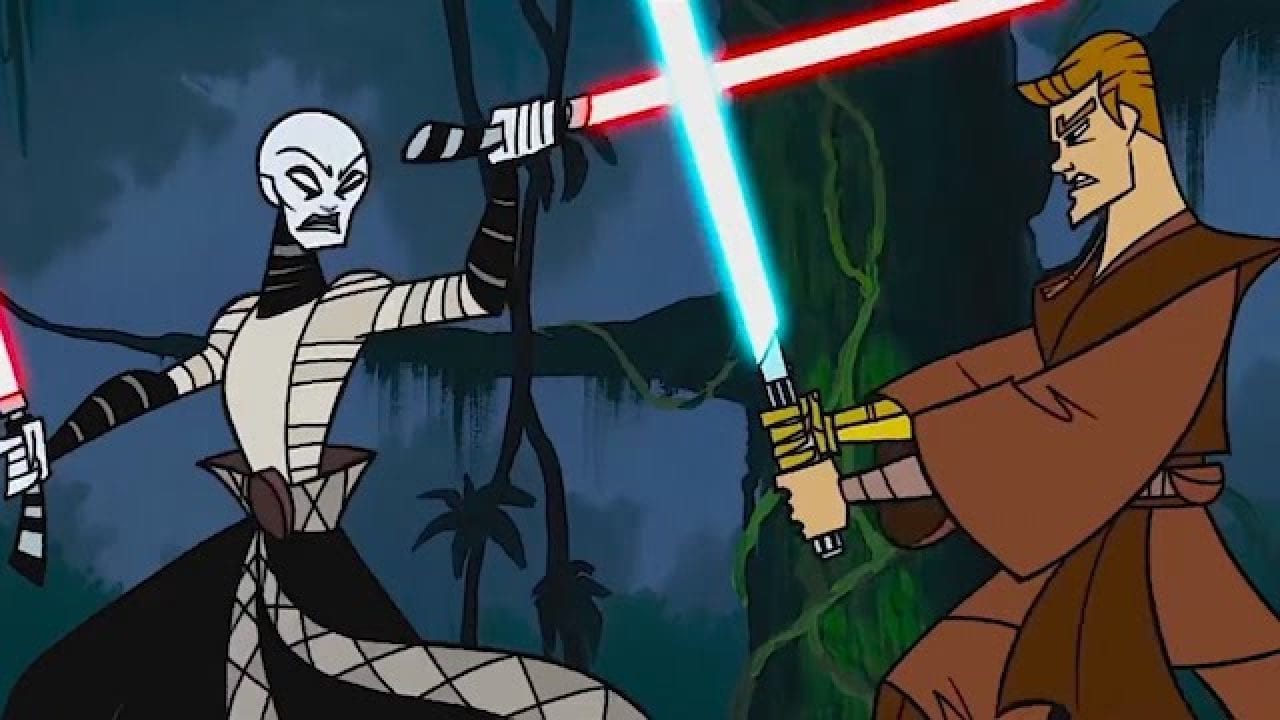Sometimes with humongous franchises like Star Wars, there are hidden gems that seem to fall through the cracks, and one of those is the severely underrated animated series Star Wars: Clone Wars – the 2003 version, that is. Now on Disney+ for the first time in two complete volumes, the series was originally made up of 15-minute minisodes, which served to fill in the backstory between Attack of the Clones and Revenge of the Sith.
The series was also created by Genndy Tartakovsky, who made some of the best-animated television shows of the 2000’s such as Samurai Jack, Dexter’s Laboratory, The Powerpuff Girls and many more. With all the Star Wars shows in development, this one is a gem and is bingeable in just two hours, and more thrilling than two-thirds of the prequel trilogy, with all the action, beautiful art design, and character development you could want! The show has won many plaudits from fans and critics alike, along with two awards for Outstanding Animated Television program at the Emmys.
It is a wonder why it has been forgotten about to such an extent, with this being one of the better things that came from the prequels. So let’s get into why you should watch this criminally underrated series.
The animation is exquisite and holds up today
With Tartakovsky, you’re guaranteed to get the best 2D animation has to offer. The colours are vivid, the characters are designed sharply; whether it be a space dogfight, a battle between armies of droids and clones, or a Jedi vs Sith lightsaber battle, you are in no short supply of astounding moments delivered with such attention to detail and vibrancy. One standout moment involves Anakin going up against Sith protégée Asaj Ventress in a lightsaber battle, that makes effective use of the colours of each combatant’s weapon to tell the story and the motivations of each character visually, and highlight the anger of Anakin and his turn towards the dark side. The show doesn’t utilise a great deal of dialogue and prefers to trade in visual storytelling, which works in the show’s favour considering a lot of the pointless dialogue the prequels have to offer.
Fills in the much-needed backstory for Anakin
Probably one of the biggest positives of the series is the way in which it fills in much-needed context for Anakin and his turn to the dark side. If you’ve seen Revenge of the Sith, then you’ll know that Anakin turns to the dark side quicker than a government U-turn. With this micro-series however, the turn towards the dark side makes sense considering all the challenges Anakin has to face, whether physically or psychologically, his faith tested by the trials of the Clone Wars. One of the aforementioned problems with the prequels is the dialogue, so, thankfully, the Anakin here doesn’t speak too much, and his actions—like most of the characters—are told through actions rather than words. Anakin gets some good one-liners and appears much less whiny than in the prequel trilogy; even voice actor Mat Lucas does a spot on Anakin impression, but without all the clunky characterisation, whether that be from Lucas’s writing or Hayden Christensen’s performance.
The action
Not that action is the be-all or end-all of Star Wars, but it is a key component of what makes an excellent Star Wars story. This show has probably double the levels of action in the prequel trilogy, meaning you will never be bored. The show makes sure action is abundant, from space dogfights, to lightsaber duels, to vast armies facing each other. The action represents the scale and significance of the Clone Wars (which is barely touched upon in the films), and adds context for the larger fight at hand with the Separatists, along with how characters like Anakin, Obi-Wan and the Chancellor develop over the course of the prequels.
Allowed for The Clone Wars (2008-2020) to be made
This series of minisodes paved the way for the immensely successful Star Wars: The Clone Wars. The main difference between the two is the animation styles, with the later series employing a more contemporary 3D animation style, but also featured longer episodes and more seasons to tell a variety of stories. Without the 2003 original, The Clone Wars wouldn’t exist, wouldn’t become the cult fan-favourite it is today, or allow The Clone Wars to take more time to explore various characters in depth, compared to the brisk nature of the miniseries.
Overall, this hidden gem of a show deserves to be appreciated as one of the best things that came from the prequels. A fast, fun, and interesting look at the Clone Wars that you will be watching again and again.
Words by Brett Herlingshaw
Support The Indiependent
We’re trying to raise £200 a month to help cover our operational costs. This includes our ‘Writer of the Month’ awards, where we recognise the amazing work produced by our contributor team. If you’ve enjoyed reading our site, we’d really appreciate it if you could donate to The Indiependent. Whether you can give £1 or £10, you’d be making a huge difference to our small team.
